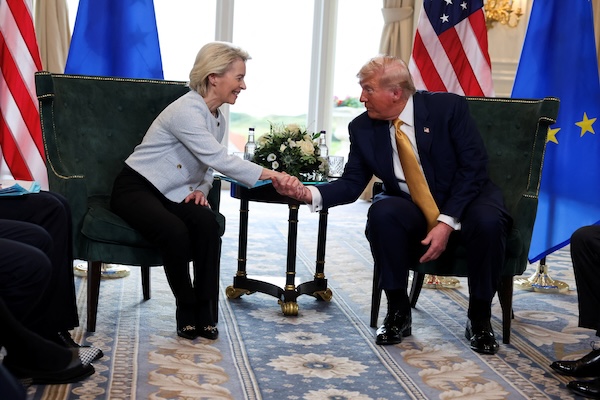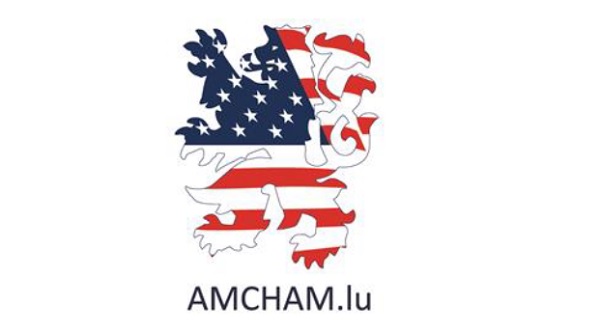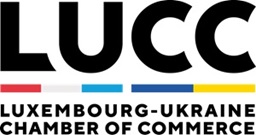 US President Donald Trump shakes hands with European Commission President Ursula von der Leyen, in Turnberry, Scotland, UK, 27 July 2025;
Credit: Reuters/Evelyn Hockstein
US President Donald Trump shakes hands with European Commission President Ursula von der Leyen, in Turnberry, Scotland, UK, 27 July 2025;
Credit: Reuters/Evelyn Hockstein
TURNBERRY, Scotland (Reuters) - The US struck a framework trade agreement with the European Union on Sunday 27 July 2025, imposing a 15% import tariff on most EU goods - half the threatened rate - and averting a bigger trade war between the two allies that account for almost a third of global trade.
US President Donald Trump and European Commission President Ursula von der Leyen announced the deal at Trump's luxury golf course in western Scotland after an hour-long meeting that pushed the hard-fought deal over the line, following months of negotiations.
"I think this is the biggest deal ever made," Trump told reporters, lauding EU plans to invest some $600 billion in the United States and dramatically increase its purchases of US energy and military equipment.
Trump said the deal, which tops a $550 billion deal signed with Japan last week, would expand ties between the trans-Atlantic powers after years of what he called unfair treatment of US exporters.
Von der Leyen, describing Trump as a tough negotiator, said the 15% tariff applied "across the board", later telling reporters it was "the best we could get."
"We have a trade deal between the two largest economies in the world, and it's a big deal. It's a huge deal. It will bring stability. It will bring predictability," she said.
The agreement mirrors key parts of the framework accord reached by the US with Japan, but like that deal, it leaves many questions open, including tariff rates on spirits, a highly charged topic for many on both sides of the Atlantic.
The deal, which Trump said calls for $750 billion of EU purchases of US energy in coming years and "hundreds of billions of dollars" of arms purchases, likely spells good news for a host of EU companies, including Airbus, Mercedes-Benz and Novo Nordisk, if all the details hold.
German Chancellor Friedrich Merz welcomed the deal, saying it averted a trade conflict that would have hit Germany's export-driven economy and its large auto sector hard. German carmakers, VW, Mercedes and BMW were some of the hardest hit by the 27.5% US tariff on car and parts imports now in place.
The baseline 15% tariff will still be seen by many in Europe as too high, compared with Europe's initial hopes to secure a zero-for-zero tariff deal.
Bernd Lange, the German Social Democrat who heads the European Parliament's trade committee, said the tariffs were imbalanced and the hefty EU investment earmarked for the US would likely come at the bloc's own expense.
Trump retains the ability to increase the tariffs in the future if European countries do not live up to their investment commitments, a senior US administration official told reporters on Sunday evening.
The euro rose around 0.2% against the dollar, sterling and yen within an hour of the deal's being announced.
Mirror of Japan deal
Carsten Nickel, deputy director of research at Teneo, said Sunday's accord was "merely a high-level, political agreement" that could not replace a carefully hammered out trade deal: "This, in turn, creates the risk of different interpretations along the way, as seen immediately after the conclusion of the US-Japan deal."
While the tariff applies to most goods, including semiconductors and pharmaceuticals, there are exceptions.
The US will keep in place a 50% tariff on steel and aluminium. Von der Leyen suggested the tariff could be replaced with a quota system; a senior administration official said EU leaders had asked that the two sides continue to talk about the issue.
Von der Leyen said there would be no tariffs from either side on aircraft and aircraft parts, certain chemicals, certain generic drugs, semiconductor equipment, some agricultural products, natural resources and critical raw materials.
"We will keep working to add more products to this list," von der Leyen said, adding that spirits were still under discussion.
A US official said the tariff rate on commercial aircraft would remain at zero for now, and the parties would decide together what to do after a US review is completed, adding there is a "reasonably good chance" they could agree to a lower tariff than 15%. No timing was given for when that probe would be completed.
The deal will be sold as a triumph for Trump, who is seeking to reorder the global economy and reduce decades-old US trade deficits, and has already reached similar framework accords with the UK, Japan, Indonesia and Vietnam, although his administration has not hit its goal of "90 deals in 90 days."
US officials said the EU had agreed to lower non-tariff barriers for automobiles and some agricultural products, though EU officials suggested the details of those standards were still under discussion.
"Remember, their economy is $20 trillion ... they are five times bigger than Japan," a senior US official told reporters during a briefing. "So the opportunity of opening their market is enormous for our farmers, our fishermen, our ranchers, all our industrial products, all our businesses."
Trump has periodically railed against the EU, saying it was "formed to screw the United States" on trade. He has fumed for years about the US merchandise trade deficit with the EU, which in 2024 reached $235 billion, according to US Census Bureau data.
The EU points to the US surplus in services, which it says partially redresses the balance.
Trump has argued that his tariffs are bringing in "hundreds of billions of dollars" in revenues for the US while dismissing warnings from economists about the risk of inflation.
On 12 July 2025, Trump threatened to apply a 30% tariff on imports from the EU starting on Friday 1 August 2025, after weeks of negotiations failed to reach a comprehensive trade deal.
The EU had prepared counter-tariffs on 93 billion euros of US goods in the event a deal to avoid the tariffs could not be struck.








